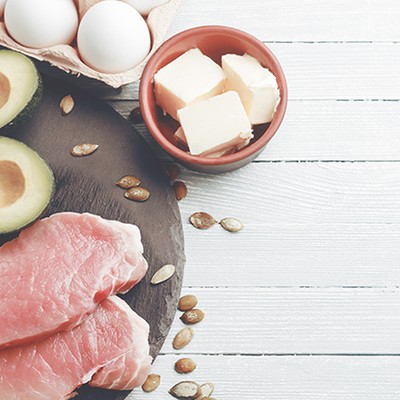
What’s The Deal With The Keto Diet?
What’s the concept?
While low-carb diets are nothing new (Atkins and South Beach have had a cult following for decades), the ketogenic diet goes one step further. Under the plan, you’re supposed to get a whopping 80% of your daily calories from fats, 15% from protein and only 5% from carbs – a ratio that science has shown to be effective when it comes to weight loss.
How does it work?
The underlying concept of the ketogenic diet, in simple terms, is to change the body’s primary fuel source from glucose to fat. Modern society lives on a relatively high carbohydrate diet that’s made up of around 55% carbs, 30% fat and 15% protein. Once ingested, carbs are broken down into sugar (insulin and glucose) in the blood. If this energy isn’t used by the body, the extra calories are stored as body fat. Restricting glucose levels through a low carb diet forces the body to burn fat instead (this process is known as ketosis) – the keto diet has shown that when people make this switch, excess body fat can be lost pretty quickly, even though a high amount of fat and calories are being consumed.
What are the benefits?
While it’s true the ketogenic diet’s reputation for causing rapid weight loss is appealing to more people than ever (Halle Berry, Adriana Lima, Megan Fox and Kim Kardashian all claim to be fans), the diet is beneficial for far more than burning body fat. In fact, the diet wasn’t even treated with weight loss in mind – it’s actually been used since the 1920s to help doctors treat patients with conditions like diabetes, epilepsy and neurological disorders. Other benefits include…
- Improved Cognitive Health: Studies have suggested that burning ketones, and being in a state of ketosis, is a ‘cleaner’ way to stay energised compared to running on carbs and sugar.
- Decreased Cravings: Protein and fats lead to increased satiety and fullness much more so than sugary foods and refined grains. This is due, in part, to the positive effect fats and protein have on appetite-controlling hormones, including ghrelin.
- Reduced Risk For Chronic Disease: By helping to improve inflammation and insulin sensitivity, the diet may help to reduce the risk of diabetes, heart disease and even cancer.
- Hormonal Health: By normalizing blood sugar, the diet can help to treat hormonal conditions such as polycystic ovary syndrome (PCOS).
- Improved Metabolism: The ketogenic diet is unique in that it boosts fat burning without reducing your resting metabolic rate, which is essentially the opposite of most reduced-calorie diets.
What can you eat?
Fat sources should make up the bulk of your diet – splurge on avocados, coconut oil, egg yolks, fatty nuts (macadamias, Brazil nuts and walnuts but avoid cashews as these tend to be higher in carbs), olive oil, cheese and fatty meats like bacon and sardines. You should be aiming to have two to three servings per meal, and six or nine daily. Be sure to eat plenty of protein too, aiming for 0.6/0.8g per pound of body weight, but make sure this is less than total fat – aim for 25g of protein per meal. Lastly, not all vegetables are allowed on the diet (as a general rule, anything grown below ground, i.e. root vegetables, should be avoided), but greens such as spinach, kale, chard and lettuce are fine.
What does a typical day look like?
A typical day on the diet could start with scrambled eggs or an omelette; lunch might be a chicken breast with a handful of greens, olive oil and nuts followed by baked salmon and a Caprese salad. If you get hungry throughout the day, you can have a protein shake made with a full carton of coconut cream (milk is deemed too high carb) although purists say if you do feel hungry between meals you’re not eating enough fat. In short, every meal should be brimming with healthy fats, a small amount of protein and very few carbs, ideally in the form of green vegetables.
Are there any side effects?
Limiting your carb and fibre intake means constipation can be a real problem and leading London Nutritionist, Lily Soutter, warns cutting back on fruit and vegetables (all of which are carbs) can lead to nutritional deficiencies and affect gut health by effectively removing fibre, the main food source for your gut microbiome. ‘Keto flu’ is also another common side effect – some people who switch from glucose to ketones for fuel find they suffer flu-like symptoms including headaches, nausea and fatigue.
Is it better suited to some people more than others?
Yes and no. The most popular and trendy use for the ketogenic diet is weight loss. Some studies have show that in the short-term (3-6 months), weight may be lost more quickly on a low carb diet in comparison to a low fat diet, however long term (1 year) there is no significant difference between the two diets. The keto diet can be difficult to sustain long term and cutting out food groups may not necessarily be healthy for the body.
The bottom line?
If you have weight to lose, struggle with sugar cravings and feel your energy levels could do with a boost, it could well worth be trying the keto diet. However, appreciate it’s a drastic diet that needs properly researching to see if it’s sustainable for you and your lifestyle.
DISCLAIMER: We endeavour to always credit the correct original source of every image we use. If you think a credit may be incorrect, please contact us at info@sheerluxe.com.